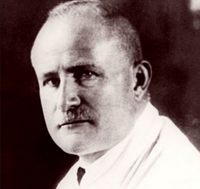










Hans Berger was a German neurologist, best known as the inventor of electroencephalography (EEG) (the recording of "brain waves") in 1924, coining the name,and the discoverer of the alpha wave rhythm known as "Berger's wave".
Biography:
The son of Paul Friedrich Berger and of Anna Rückert, Berger graduated from the Gymnasium at Coburg and then entered the University of Jena in 1892. After one semester in astronomy he transferred to medicine. In 1897 he became assistant to Otto Binswanger at the university’s psychiatric clinic. He was appointed chief doctor in 1912 and director and professor of psychiatry in 1919; he retired in 1938. His associates described Berger as punctual, strict, demanding, and reserved.
The central theme in Berger’s work was the search for the correlation between objective activity of the brain and subjective psychic phenomena. In his work on blood circulation in the brain (1901) he described his efforts to gain insight into this correlation through plethysmographic registration of the brain pulsations. He investigated the influence of the heartbeat, respiration, vasomotor functions, and position of the head and body on brain pulsations, which were measured through an opening, made by trephination, in the skull. Berger also studied the effects of a number of medications—such as camphor, digitoxin, caffeine, cocaine, and morphine—on brain pulsations. The results of these investigations were disappointing, yet Berger continued his search for measurable expressions of psychic conditions through experiments on blood circulation (1904, 1907).
After 1907 Berger tried to discover a correlation between the temperature of the brain and psychic processes. He postulated that through dissimilation in the cortex, psychic energy (P-Energie) develops, along with heat, electrical energy, and neural energy. These experiments also came to a dead end, according to Berger’s publication of 1910. Nevertheless, in his lectures on psychophysiology, given from 1905 on and published in 1921, the problem of P-Energie Continued to hold his interest. His tenaciousness in this matter is apparent from a memo in his journal dated 14 December 1921, in which he says that the goal of his research continues to be the correlation between the expressions of the human mind and the processes of dissimilation the in brain.
After his disappointing experiments measuring the blood circulation and temperature of the brain, Berger (following his return from World War I) devoted himself mainly to the measurement of the brain’s electrical activity. In 1902 he had taken measurements of electrical activity above skull defects with the Lippmann capillary electrometer, and later with the Edelmann galvanometer. In 1910, however, Berger mentioned in his journal that the results of these measurements were not satisfactory. Therefore, until 1925 he followed two methods of research: stimulation of the motor cortex through a defect in the skull, measuring the time between stimulus and contralateral motor reaction, and registration of the spontaneous potential differences of the brain surface. After 1925 Berger no longer used the stimulation method. He specialized, with ever increasing skill, in registering the spontaneous fluctuations in electrical potential that could be recorded through the skull from the cortex. In his first publication on electro-encephalography (1929), he called 6 July 1924 the date of discovery of the human electroencephalogram. The EEG, the curves of the electrical potentials measured again and again between two points of the skull, did not give him a closer insight into the correlation between the electrical activity of the brain and psychic energy. However, electroencephalography has proved to be of ever increasing importance in diagnosing and treating neurological diseases (epilepsy, brain tumors, traumata).
Berger’s work was strongly influenced by the exact psychology of the nineteenth century. In developing his psychophysiology, Berger used the ideas of J. F. Herbart, R. H. Lotze, G. T. Fechner, W. Wundt, and the Danish psychologist A. Lehmann as a base. In the experimental field, Berger was in all aspects a follower of A. Mosso. Berger’s experiments on brain circulation and brain temperature were identical with Mosso’s, and his publications on these subjects bore the same titles as Mosso’s papers.
In developing electroencephalography, Berger was influenced by Caton and by Nemminski. Caton had measured electrical potentials on the exposed cortex of experimental animals in 1875, but he was not able to record these phenomena graphically. Nemminski recorded the first electrocerebrogram on dogs with the skull intact by means of the Einthoven string galvanometer in 1913.
Berger’s historical significance lies in his discovery of the electroencephalogram of man. Although he began publishing his many papers on electroencephalography in 1929, he did not receive international recognition until Adrian and Matthews drew attention to his work in 1934.